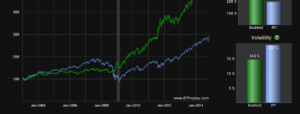U.S. small-cap stocks may likely be winners on Trump’s proposed tax cut reforms and economic buoyancy. But uncertainty will linger until Trump’s planned policies see the day of light and inflation gains traction. With the Fed remaining on the policy tightening path amid subdued inflation, market momentum can be derailed any time.
On the other hand, things are rosier in international economies. International investing has been buoyant since the beginning of this year on the improving health of several economies. Policy easing has played a major role in driving global economic growth.
Most developed economies, which were facing deflationary threats for long, are slowly returning to the inflationary track. Along with developed economies like the Euro zone and Japan, emerging markets, as a whole, are better placed now.
Though talks of a QE wrap-up or tight monetary policy were rife, the ECB announced in late October that it would extend its asset purchase program through September 2018 at a reduced rate. Economists believe that Draghi’s tone is still accommodative (read: ECB’s Dovish Taper Boosts These ETFs).
Goldman analyst Charles Himmelberg expects the global economy to expand 4% in 2018 on a real gross-domestic-product basis. Global GDP growth will likely be 3.8% as per Bank of America Merrill Lynch (read: Follow Goldman With These ETFs for 2018).
Why Small-Caps Better-Positioned to Play the Recovery
Small caps are considered the measure of domestic well-being. In a growing economy, these pint-sized securities perform the best as these generate most of their revenues from the domestic market. These are less ruffled by global economic turmoil.
A wave of cheap money in international markets will lead to stepped-up economic activities, and raise business and consumer confidence. This in turn will benefit small-cap companies.
Probably, thanks to this diverging economic background, international small-cap ETFs hit a 52-week high lately.













Leave A Comment